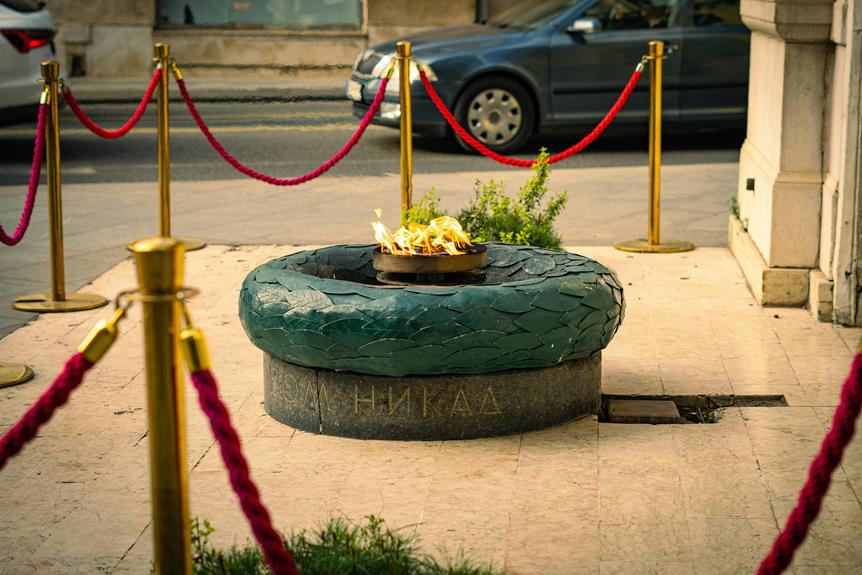Genocide memorials stand as somber tributes to the darkest chapters of human history, embodying the pain and suffering of those who perished. Their significance goes beyond mere remembrance; they serve as powerful catalysts for introspection and societal reckoning. By exploring the intricate interplay between memory, trauma, and healing, these memorials challenge us to confront uncomfortable truths and grapple with the complexities of reconciliation. In examining the nuanced role of genocide memorials, one uncovers a profound journey of resilience, resistance, and resilience that continues to shape our collective understanding of humanity's capacity for both atrocity and redemption.
Key Takeaways
- Genocide memorials serve as poignant reminders of past atrocities.
- They provide space for collective grieving, healing, and honoring victims' memories.
- Memorials play a crucial role in conveying complex historical narratives.
- Design elements evoke emotional responses and prompt deep reflection.
- Locations of memorials carry historical significance and highlight past tragedies.
Importance of Genocide Memorials
The significance of genocide memorials lies in their ability to serve as poignant reminders of past atrocities and as educational tools for fostering remembrance and understanding. These memorials hold immense emotional significance for communities affected by genocide, providing a space for collective grieving, healing, and honoring the memories of the victims. By preserving the stories and experiences of those who suffered, these memorials contribute to cultural remembrance, ensuring that future generations learn about the dark chapters of history and work towards preventing such atrocities from happening again.
Genocide memorials play an essential role in acknowledging the pain and trauma endured by survivors and their descendants. They offer a physical manifestation of collective memory, allowing individuals to confront the horrors of the past while paying tribute to the resilience and strength of those who survived. Through exhibits, artifacts, and interactive displays, these memorials serve as educational tools, raising awareness about the causes and consequences of genocide and promoting empathy and understanding among visitors.
Moreover, genocide memorials serve as important sites for truth-telling and reconciliation. By confronting the atrocities of the past and acknowledging the role of perpetrators, these memorials contribute to the process of healing and rebuilding trust within affected communities. They also serve as symbols of hope, resilience, and the enduring power of remembrance in shaping a more just and peaceful future.
Symbolism in Memorial Design
Symbolism in memorial design plays a crucial role in conveying complex historical narratives and evoking emotional responses from visitors. The use of symbolism in architecture helps memorial sites communicate the gravity of past events and honor the memory of those affected by genocide. Architects and artists often incorporate symbolic elements into the design of memorials to create a powerful visual language that resonates with visitors on a deeper level.
In memorial design, symbolism can be manifested through various architectural features such as the choice of materials, shapes, and spatial arrangements. For example, the use of black marble may symbolize mourning and remembrance, while water features like fountains or reflecting pools can represent healing and renewal. The arrangement of pathways and structures within a memorial site can also symbolize the journey from darkness to light or chaos to peace.
Moreover, symbolic elements in memorial design serve to educate visitors about the historical context of the genocide and evoke empathy and reflection. By engaging with symbolic representations of loss, resilience, and hope, visitors are encouraged to contemplate the significance of the memorial and its connection to the broader human experience. Ultimately, the careful integration of symbolism in memorial architecture helps create a profound and lasting impact on those who visit these important historical sites.
Impact on Visitor Reflection
Through immersive engagement with symbolic representations in memorial architecture, visitors are prompted to deeply reflect on the historical significance of genocide memorials. The visitor experience within these memorials is often significant, evoking a range of emotions and fostering a deeper understanding of the atrocities that occurred. As visitors walk through the solemn spaces, they are confronted with visual reminders of the past, such as sculptures, inscriptions, and artifacts that serve as powerful symbols of remembrance.
The emotional response elicited from visitors is an important aspect of the impact of genocide memorials on visitor reflection. Many individuals report feelings of sorrow, empathy, anger, and even guilt as they contemplate the horrors of genocide and the lives lost. These emotional reactions can lead to introspection, sparking conversations about the importance of remembrance, the consequences of hatred, and the significance of working towards a more peaceful future.
Moreover, the design elements of these memorials play a key role in shaping the visitor experience and influencing their emotional response. Architectural features, spatial layouts, and interactive exhibits all contribute to creating a somber yet contemplative atmosphere that encourages visitors to engage with the history of genocide on a personal and emotional level. Overall, the impact of genocide memorials on visitor reflection is profound, challenging individuals to reflect on the past and consider their role in shaping a more tolerant and inclusive society.
Role in Historical Education
In considering the educational value of genocide memorials, a closer examination reveals their significant role in fostering historical awareness and understanding. Genocide memorials serve as vital educational tools, providing visitors with a tangible connection to past atrocities and serving as reminders of the consequences of hatred and intolerance. These memorials play an essential role in preserving historical memory and ensuring that future generations are informed about the atrocities that have occurred.
One of the key aspects of the educational significance of genocide memorials is their ability to facilitate impactful learning experiences. By engaging with memorials, visitors are confronted with the harsh realities of genocide, fostering empathy, compassion, and a deeper understanding of historical events. The emotional impact of standing in the presence of a memorial dedicated to the victims of genocide can create a lasting impression that encourages reflection and critical thinking.
Furthermore, genocide memorials contribute to a more detailed understanding of history by providing context and detail about past events. Through exhibits, interactive displays, and educational programs, these memorials offer visitors the opportunity to explore the intricacies of genocide, exploring its causes, consequences, and broader historical significance.
Commemoration of Victims
The commemoration of victims through genocide memorials serves as a solemn and poignant reminder of the human cost of atrocity and the importance of honoring those who have suffered unimaginable horrors. These memorials play an essential role in society by providing a space for emotional remembrance and reflection, allowing individuals to pay tribute to the lives lost and acknowledge the suffering endured by countless individuals.
Through the act of visiting these memorials, individuals engage in a healing process, both personally and collectively. The emotional impact of witnessing these sites fosters empathy and understanding, encouraging visitors to confront the harsh realities of genocide and its lasting effects on communities and societies. By confronting these painful truths, individuals can begin to heal from the trauma of the past and work towards building a more compassionate and just future.
Genocide memorials serve as a powerful tool for education, ensuring that the stories of the victims are never forgotten and providing a stark reminder of the consequences of hatred and intolerance. By actively engaging with these memorials, individuals are challenged to reflect on the past and consider how they can contribute to a more peaceful and inclusive world. In this way, commemoration through genocide memorials becomes an integral component in the ongoing fight against injustice and a tribute to the resilience of those who have suffered.
Global Diversity of Memorials
Examining the global landscape of genocide memorials reveals a rich tapestry of diverse forms, each uniquely representing the historical and cultural contexts of the atrocities they commemorate. Cultural differences play a significant role in shaping these memorials, influencing their design, symbolism, and rituals. From the stark simplicity of the Kigali Genocide Memorial in Rwanda to the intricate artistic details of the Berlin Holocaust Memorial in Germany, each memorial reflects the specific cultural nuances of the affected communities.
Architectural styles also vary widely across genocide memorials worldwide. The Memorial to the Murdered Jews of Europe in Berlin, with its grid of concrete slabs, evokes a sense of disorientation and isolation, inviting visitors to contemplate the enormity of the Holocaust. In contrast, the Memorial to the Victims of Communism in Prague features a series of bronze figures descending a flight of stairs, symbolizing the gradual loss of freedom under oppressive regimes.
Furthermore, the location of these memorials often carries historical significance. The Nanjing Massacre Memorial Hall in China stands on the site of a mass grave, serving as a poignant reminder of the atrocities committed during World War II. Similarly, the National Memorial for Peace and Justice in the United States is situated in Montgomery, Alabama, where many African Americans were lynched, highlighting the country's history of racial violence.
Challenges in Memorial Preservation
Exploring the intricate challenges of memorial preservation requires a nuanced understanding of historical significance, architectural integrity, and societal engagement. Preservation challenges often stem from a variety of factors, including environmental degradation, lack of funding, political instability, and even vandalism. These obstacles can threaten the integrity and longevity of genocide memorials, making conservation efforts essential.
One of the primary preservation challenges faced by genocide memorials is the need to balance physical upkeep with maintaining the authenticity of the site. As time passes, structures may deteriorate, requiring restoration and maintenance. However, interventions must be carefully planned to guarantee that the original intent and historical accuracy of the memorial are not compromised.
Conservation efforts play an important role in addressing these challenges. Through meticulous planning and execution, conservationists work to safeguard the physical integrity of memorials while preserving their historical and cultural significance. This often involves employing advanced conservation techniques, conducting regular maintenance, and implementing measures to protect memorials from external threats.
Furthermore, engaging with local communities and stakeholders is crucial for the long-term preservation of genocide memorials. By fostering a sense of ownership and responsibility among the community, conservation efforts can be sustained and enhanced. Collaborative initiatives that involve education, outreach, and advocacy can also help raise awareness about the importance of memorial preservation, ensuring the continued protection of these sites for future generations.
Frequently Asked Questions
How Do Genocide Memorials Address Intergenerational Trauma?
Intergenerational trauma is a complex issue that can be addressed through various methods, including therapy, community support, and cultural practices.
Commemoration rituals play an essential role in acknowledging past atrocities and promoting healing across generations.
Are There Controversies Surrounding the Funding of These Memorials?
Ethical implications arise when controversies surround the funding of memorials, emphasizing the importance of financial transparency. Ensuring that funds are sourced ethically and allocated appropriately is vital to maintaining the integrity of memorial projects.
Lack of transparency can lead to distrust and skepticism among stakeholders and the public. Addressing these concerns through clear financial reporting and accountability mechanisms is essential for upholding the ethical standards associated with memorial funding.
Do Memorials Have Specific Protocols for Visitor Behavior?
Visitor etiquette at memorials is vital. Cultural sensitivity should guide behavior. Protocols often include respecting the solemnity of the site, refraining from loud conversations or disruptive behavior, and dressing modestly out of respect for the victims.
Visitors are typically encouraged to observe a moment of silence, refrain from touching exhibits unless allowed, and follow any specific guidelines provided by the memorial staff to guarantee a respectful and meaningful experience.
What Technologies Are Used to Enhance Memorial Experiences?
In the domain of commemorative sites and museums, cutting-edge technologies like virtual reality and interactive exhibits have revolutionized the visitor experience. These tools offer immersive and engaging ways for individuals to connect with historical events and personal stories.
How Do Memorials Adapt to Changing Societal Perceptions of History?
Memorials play a vital role in reflecting changing societal perceptions of history by adapting their narratives. As societal perspectives evolve, memorials must address the responsibility of accurately portraying historical events and their impacts.
This adaptation involves reevaluating the narratives presented at memorials to guarantee they align with contemporary understandings and values. By acknowledging changing societal perceptions and embracing a sense of societal responsibility, memorials can continue to serve as relevant and educational platforms.
Conclusion
In summary, the significance of genocide memorials lies in their ability to preserve the memory of past atrocities, honor the victims, and educate future generations about the human cost of genocide.
Through their design, symbolism, and educational value, these memorials play a vital role in fostering empathy, understanding, and a commitment to preventing future atrocities.
As we reflect on the solemn spaces that commemorate the victims, we are reminded of the importance of building a more inclusive and compassionate society.


